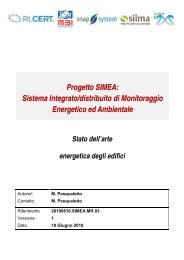Stato dell'arte energetica degli edifici - Automatica - Università degli ...
Stato dell'arte energetica degli edifici - Automatica - Università degli ...
Stato dell'arte energetica degli edifici - Automatica - Università degli ...
Create successful ePaper yourself
Turn your PDF publications into a flip-book with our unique Google optimized e-Paper software.
SIMEA <strong>Stato</strong> dell’arte <strong>energetica</strong> <strong>degli</strong> <strong>edifici</strong><br />
56<br />
Doc.No 20100610.SIMEA.MR.03<br />
Versione 1<br />
and operational attribution is achieved by selecting products and entities from the support databases and<br />
associating these with the surfaces and spaces comprising the problem. Models can be further attributed to<br />
account for temporal shading and insulation patterns, explicit radiation view factors, facade-integrated<br />
photovoltaic modules, temperature dependent thermo physical properties and CFD domains. As required,<br />
component networks can be defined to represent, for example, HVAC systems, distributed fluid flow (for the<br />
building-side air or plant-side working fluids) and electrical distribution systems.<br />
Simulations: with ESP-r functionality follows description - simple models and operating regimes<br />
composed in a few minutes can be extended, in steps, to encompass the simultaneous solution of fabric<br />
(1/2/3D), air flow (network and/or coupled, transient CFD), electrical power, embedded renewables, plant<br />
system components, indoor air quality and lighting assessments via Radiance. Building and flow simulations<br />
can be undertaken at frequencies of one minute to one hour and system simulations can be from fractions of<br />
a second to an hour.<br />
1.2.28.6. Output<br />
Results analysis modules are used to view the simulation results, undertake a variety of performance<br />
appraisals and explore the interactions between assessment domains. Tools are provided to enable the<br />
construction of an Integrated Performance View which summaries performance over a range of relevant<br />
criteria. Changes to the model parameters can then follow depending on these appraisals. The range of<br />
analyses is essentially unrestricted and data can be exported to other analysis and graphing tools.<br />
1.2.28.7. Computer Platform<br />
Sun-Solaris, Silicon Graphics: Sparc5 or newer, 96+MB memory.<br />
Linux (Redhat/ Mandrake/ SUSE etc): Pentium or newer, 128+MB memory.<br />
Mac OS X 10.1 or newer, 128+MB memory.<br />
Windows NT/2000/XP (graphic mode running under Cygwin), Pentium or newer, 128+MB memory.<br />
Windows NT/2000/XP (console application for batch processing), Pentium or newer, 128+MB memory.<br />
Disk requirements: ~12MB source distribution, ~200MB executables/libraries/example problems, 50-<br />
500MB user project folders.<br />
1.2.28.8. Programming Language<br />
C and FORTRAN (F77 or F90) Compiles with most Unix and Linux compilers, GNU compilers and<br />
MINGW.<br />
1.2.28.9. Strengths<br />
ESP-r is flexible and powerful enough to simulate many innovative or leading edge technologies<br />
including daylight utilization, natural ventilation, combined heat and electrical power generation and<br />
photovoltaic facades, CFD, multi-gridding, and control systems. An active user community and mailing list<br />
ensures a quick response to technical issues.<br />
1.2.28.10. Weaknesses<br />
It is a general purpose tool and the extent of the options and level of detail slows the learning process.<br />
Specialist features require knowledge of the particular subject. Although robust and used for consulting by<br />
some groups, ESP-r still shows its research roots.
















